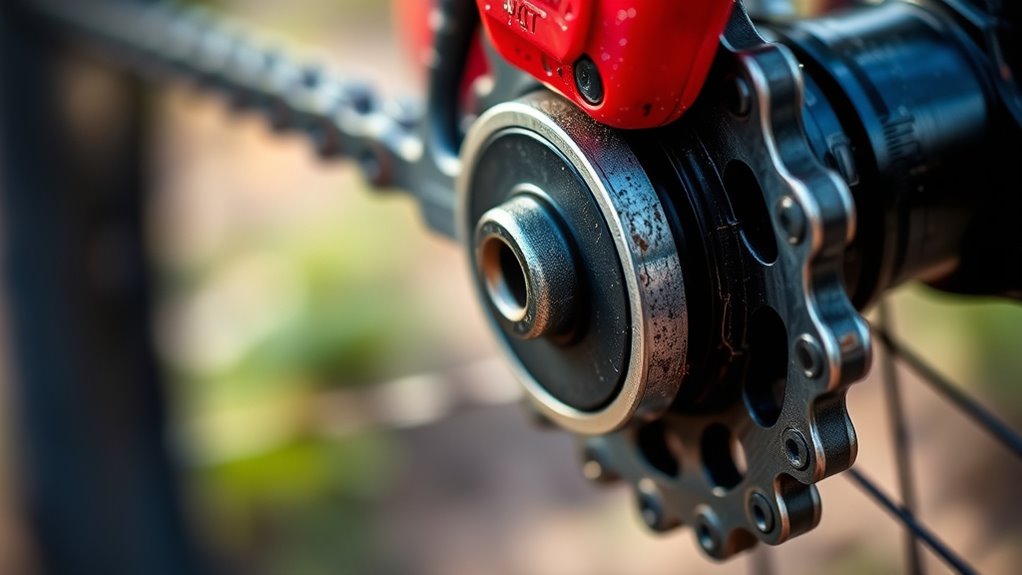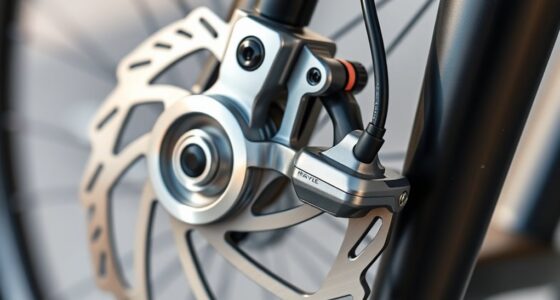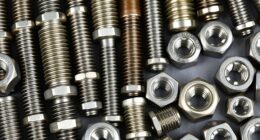A chain drop often happens when your motorcycle’s chain is too loose or misaligned, causing it to slip off the sprockets unexpectedly. It can also occur if the derailleur isn’t properly adjusted or if your chain isn’t well-maintained, such as being dirty or poorly lubricated. Regularly check your chain tension, keep the drivetrain clean, and make sure your derailleur is correctly set up. Keep going to discover more ways to prevent this common issue.
Key Takeaways
- Improper chain tension, whether too loose or tight, can cause the chain to slip off sprockets.
- Misaligned or poorly adjusted derailleur increases the risk of chain derailment during gear shifts.
- Excessive slack in the chain leads to derailment, especially during acceleration or sudden movements.
- Regularly inspect and adjust chain tension according to manufacturer specifications to prevent drop issues.
- Keep the chain clean and lubricated; neglecting maintenance can cause chain slack and misalignment.

A chain drop occurs when a motorcycle chain unexpectedly slips off the sprockets while riding, potentially causing a sudden loss of power and control. This can be startling and dangerous, especially if you’re not prepared for it. One common cause of chain drops is improper chain tension. If your chain is too loose, it can easily derail when you accelerate or shift gears. Conversely, if it’s too tight, it can put undue strain on your sprockets and derailleur, increasing the risk of slipping off. To prevent this, you need to regularly check and adjust the chain tension. Refer to your motorcycle’s manual for the correct tension specifications, and use a reliable tension gauge or measure the slack by hand at the tightest section of the chain. Proper tension ensures the chain stays aligned with the sprockets under normal riding conditions, reducing the chances of derailment.
Another critical factor is derailleur adjustment, especially if your motorcycle uses a derailleur-based chain system. An improperly adjusted derailleur can cause the chain to shift incorrectly, increasing the likelihood of it slipping off during riding. When adjusting the derailleur, focus on the limit screws and indexing. Limit screws control how far the derailleur moves in either direction, preventing the chain from overshooting the sprockets. If these are set too tight or too loose, the chain might not sit properly on the sprockets, leading to drops. Indexing involves aligning the derailleur with each sprocket so that gear changes feel smooth and accurate. If shifting feels off, or if the chain frequently derails, you may need to fine-tune the derailleur’s position. Carefully follow the instructions in your manual, adjusting the cable tension and limit screws until the chain runs smoothly across all gears.
Regular maintenance is key to avoiding chain drops. Check your chain tension and derailleur alignment every few rides, especially after long trips or rough terrain. Clean and lubricate your chain frequently to keep it flexible and reduce wear, which can contribute to slack and misalignment. When you notice signs of excessive slack or difficulty shifting, don’t delay in making adjustments. Many issues can be fixed with a simple tweak of the derailleur or a quick tightening of the chain. Staying attentive to these details helps ensure your chain remains secure, your riding remains smooth, and the risk of a chain drop is minimized. Remember, a well-maintained chain not only prevents accidents but also prolongs the lifespan of your entire drivetrain. Additionally, understanding the importance of high-quality components can contribute significantly to overall chain stability and safety.
Frequently Asked Questions
How Often Should I Lubricate My Bike Chain?
You should lubricate your bike chain every 100 to 200 miles or after riding in wet or muddy conditions. Following a regular maintenance schedule helps prevent chain drop and ensures smooth rides. Use proper chain lubrication to reduce wear and friction. Keep an eye on the chain’s condition, and re-lubricate as needed. Regular maintenance not only prolongs your chain’s life but also keeps your bike running efficiently.
Can Chain Drop Damage My Bike?
Yes, chain drop can damage your bike like a runaway train threatening its tracks. When the chain slips, it strains the chain tension and misaligns the gears, causing wear and potential damage to the sprockets and derailleur. Over time, this chaos can lead to costly repairs. Keeping your chain properly tensioned and ensuring gear alignment helps prevent this damage, keeping your ride smooth and safe.
Is Chain Drop Common in All Bike Types?
Chain drop isn’t common across all bike types, but it can happen in mountain biking and road cycling. Mountain bikers often face more chain drops due to rough terrain and aggressive shifting, while road cyclists experience it less frequently but still occasionally. Your riding style, gear setup, and maintenance influence how often chain drops occur. Staying attentive, ensuring proper gear alignment, and regular maintenance help minimize the chances, regardless of your bike type.
How Do Weather Conditions Affect Chain Drop?
Weather impact can considerably affect chain drop, especially in wet or muddy conditions. Moisture causes dirt and debris to stick to your chain, increasing the risk of slipping or dropping. Proper chain lubrication becomes crucial in such weather, as it helps keep the chain smooth and resistant to harsh elements. Regularly cleaning and lubricating your chain guarantees peak performance, reducing the chances of chain drop no matter what weather you’re riding in.
When Should I Replace My Bike Chain?
Ever wondered if your bike chain needs replacing? You should replace it when chain wear exceeds 0.5% to 0.75%, which you can check with a chain checker tool. Also, inspect sprocket condition for worn teeth. If your chain slips or shifts poorly, it’s a sign it’s time for a new one. Regular maintenance helps avoid chain drop and keeps your ride smooth and safe.
Conclusion
Understanding why your chain drops can save you time and frustration. Regular maintenance and proper tension are key fixes, ensuring smoother rides and longer chain life. Did you know that a well-maintained chain can last up to 70% longer? Staying proactive with your bike’s chain not only improves performance but also saves you money in the long run. Keep an eye on it, and you’ll enjoy a safer, more reliable ride every time.








